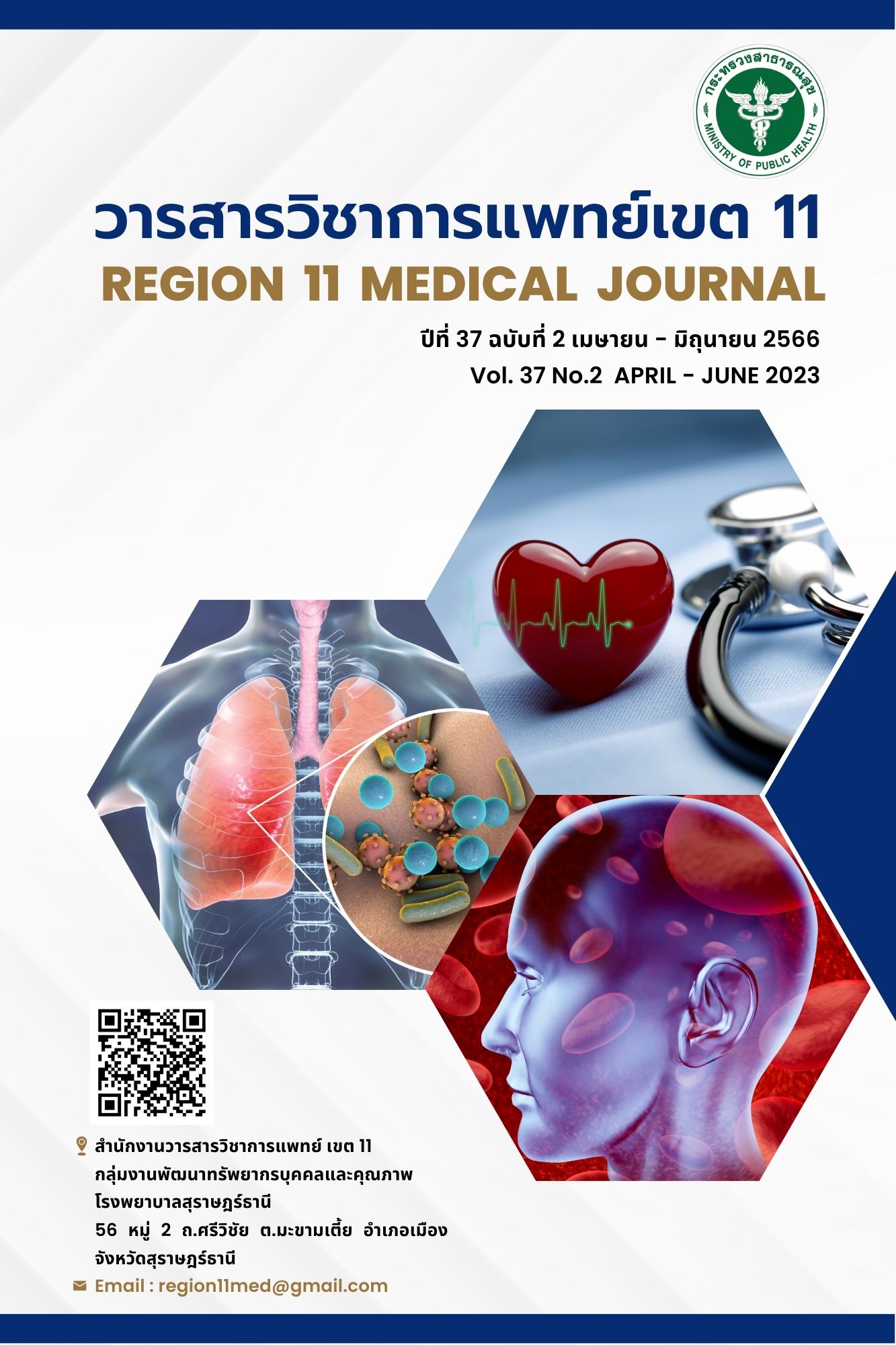Factors associated with intracerebral hemorrhage after intravenous thrombolysis in Patients with acute ischemic stroke in Kanchanadit hospital, Suratthani Province
Keywords:
Acute ischemic Stroke, Intracerebral hemorrhage, Thrombolysis, FactorsAbstract
Introduction: Acute ischemic stroke is a medical emergency condition. Intravenous thrombolysis within 4.5 hours is a gold standard treatment for decrease disability and increase quality of life in patient. Intracerebral hemorrhage is important complication after intravenous thrombolysis. To explore risk of developing intracerebral hemorrhage for close monitoring in stroke unit and management to prevent intracerebral hemorrhage in patient with acute ischemic stroke. Thus, this study aimed to evaluate factors associated with intracerebral hemorrhage in patient with acute ischemic stroke.
Objective: To identify factors associated with intracerebral hemorrhage after intravenous thrombolysis in patient with acute ischemic stroke.
Methods: A retrospective cohort study of patients with acute ischemic stroke in stroke unit of Kanchanadit hospital was conducted between July 2019 and March 2022. All patients with principal diagnosis of acute ischemic stroke, codes (International Classification of Diseases, Tenth Revision code [ICD-10] I60 to I69 were included. We collected clinical and laboratory informations from inpatient medical records, reviewed first computerized tomography [CT] brain before intravenous thrombolysis, and compared those variables to evaluate factors associated with intracerebral hemorrhage using multivariable logistic regression analysis.
Results: A total of 121 patients who diagnosed with acute ischemic stroke, 18 (14.9%) had intracerebral hemorrhage. Factors significantly associated with intracerebral hemorrhage were history of aspirin therapy (adjusted Odds Ratio [aOR] 2.63, 95% confidence interval [CI] 0.25-26.87, P < 0.001) and CT brain found hyperdense artery sign (aOR 9.94, 95% CI 2.63-37.55, P = 0.001).
Conclusion: History of aspirin therapy and CT brain found hyperdense artery sign were significant factors associated with intracerebral hemorrhage in patient with acute ischemic stroke who received intravenous fibrinolytic therapy in Kanchanadit hospital.
References
สำนักงานพัฒนานโยบายสุขภาพระหว่างประเทศ. การสูญเสียปีสุขภาวะ Disability-adjusted life years: DALYs รายงานภาระโรคและการบาดเจ็บของประชากรไทย พ.ศ. 2557.
Worp Hb, Gijn JV. Clinical practice. Acute ischemic stroke. N Engl J Med 2007;357(6):572-9.
The national institute of neurological disorders and stroke rt-PA stroke study group. Tissue plasminogen activator for acute ischemic stroke. N Engl J Med 1995;333(24):1581-7.
Jantasri S, Tiamkao S, Sirikarn P. Effectiveness of Intravenous Recombinant Tissue Plasminogen Activator (rtPA) for Acute Ischemic Stroke in Udonthani Hospital versus Node-rtPA Community Hospitals. Thai J of Neurology 2020;36(4):34-55.
William N. Whiteley, Karsten Bruins Slot, Peter Fernandes, Peter Sandercock, Joanna Wardlaw. Risk Factors for Intracranial Hemorrhage in Acute Ischemic Stroke Patients Treated With Recombinant Tissue Plasminogen Activator : A Systematic Review and Meta-Analysis of 55 Studies.(Serial online) 2012 Nov (cited 2022 Mar 2);43(11):2904-9. Available from: URL:https://www.ahajournals.org/doi/epub/10.1161/STROKEAHA.112.665331.
Lin X, Cao Y, Yan J, Zhang Z, Ye Z, Huang X, et al. Risk Factors for Early Intracerebral Hemorrhage after Intravenous Thrombolysis with Alteplase. J Atheroscler Thromb. 2020;27(11):1176-82.
Siriyutwattana C, Srisuwannanukorn S, Winitprichagul S. Incidence and Associated Factors of Intracranial Hemorrhage after Intravenous Thrombolysis for Acute Ischemic Stroke in Vajira Hospital. Thai J of Neurology 2020;36(2):51-5.
ปาริชาติ ตุ้มทอง. ปัจจัยที่มีผลต่อการเกิดเลือดออกในสมองหลังการรักษาด้วยยาละลายลิ่มเลือด ในผู้ป่วยโรคหลอดเลือดสมองตีบหรืออุดตันเฉียบพลัน. 2564 [เข้าถึงเมื่อ 20 กุมภาพันธ์ 2565] เข้าถึงได้จาก: http://203.157.71.172/academic/web/files/2564/research/MA2564-002-01-0000000507-0000000484.pdf.
Tanne D, Kasner SE, Demchuk AM, Koren-Morag N, Hanson S, Grond M, et al. Markers of Increased Risk of Intracerebral Hemorrhage After Intravenous Recombinant Tissue Plasminogen Activator Therapy for Acute Ischemic Stroke in Clinical Practice. (Serial online) 2002 April (cite 2022 Feb 25) Available from: URL:https://www.ahajournals.org/doi/epub/10.1161/01.CIR.0000012747.53592.6A.
พัณน์ญรัศ พันธุ์เขียน. ปัจจัยที่มีผลต่อการเกิดเลือดออกในสมอง ตามหลังการให้รีคอมบิแนนท์ ทิชชู พลาสมิโนเจน แอคทีเวเตอร์ ทางหลอดเลือดดำ. วารสารแพทย์เขต 4-5 2558;34(2):120-30.
สิโรตม์ ศรีมหาดไทย. ปัจจัยที่มีผลต่อการมีเลือดออกในสมองสำหรับผู้ป่วยหลอดเลือดสมองอุดตันที่ได้รับยา rtPA. วารสารแพทย์เขต 4-5 2563;39(4):604-15.
สุจริต สวนกูล, ธานินทร์ โลเกศกระวี. ปัจจัยที่มีผลต่อภาวะเลือดออกในสมองภายหลังการให้ยาละลายลิ่มเลือดทางหลอดเลือดดำในผู้ป่วยโรคหลอดเลือดสมองตีบหรืออุดตันเฉียบพลัน. ลำปางเวชสาร 2559;37(2):67-74.
ตรีทิพย์ จิตต์สนิทกุล. ปัจจัยเสี่ยงของการเกิดภาวะเลือดออกในสมองในผู้ป่วยหลอดเลือดสมองตีบตันที่ได้รับการรักษาด้วยยาละลายลิ่มเลือด (rt-PA) ในโรงพยาบาลพระนครศรีอยุธยา. วารสารสมาคมเวชศาสตร์ป้องกันแห่งประเทศไทย 2564;11(2):388-404.
พิมพ์กานต์ หล่อวณิชย์, วสันต์ ลิ่มสุริยกานต์. ปัจจัยที่เกี่ยวข้องกับภาวะเลือดออกในสมองในผู้ป่วยโรคสมองขาดเลือดที่ได้รับ rtPA ในโรงพยาบาลพระนครศรีอยุธยา. วารสารโรงพยาบาลธรรมศาสตร์เฉลิมพระเกียรติ 2564;6(1):12-20.
Wang R, Zeng J, Wang F, Zhuang X, Chen X, Miao J. Risk factors of hemorrhagic transformation after intravenous thrombolysis with rt-PA in acute cerebral infarction. QJM. 2019;112(5):323-6.
Phuttharak W, Sawanyawisuth K, Sangpetngam B, Tiamkao S, Kongbunkiat K, Chotmongkol V, et al. Risk factors for intracerebral hemorrhage after treatment with recombinant tissue-type plasminogen activator for acute ischemic stroke. Asian Biomedicine 2015;9(3):397-400.
Suwanwela NC, Phanthumchinda K, Likitjaroen Y. Thrombolytic therapy in acute ischemic stroke in Asia: The first prospective evaluation. Clin Neurol Neurosurg. 2006;108(6):549-52.
Baigent C, Blackwell L, Collins R, Emberson J, Godwin J, Peto R, et al. Aspirin in the primary and secondary prevention of vascular disease: collaborative meta-analysis of individual participant data from randomized trials. Lancet 2009;373(9678):1849-60.
Sun H, Liu Y, Gong P, Zhang S, Zhou F, Zhou J. Intravenous thrombolysis for ischemic stroke with hyperdense middle cerebral artery sign: A meta-analysis. Acta Neurol Scand. 2020;141(3):193-201.
Zou M, Churilov L, He A, Campbell B, Davis SM, Yan B. Hyperdense middle cerebral artery sign is associated with increased risk of hemorrhagic transformation after intravenous thrombolysis for patients with acute ischemic stroke. J Clin Neurosci. 2013;20(7):984-7.
Derex L, Hermier M, Adeleine P, Pialat JB, Wiart M, Berthezène Y, et al. Clinical and imaging predictors of intracerebral hemorrhage in stroke patients treated with intravenous tissue plasminogen activator. J Neurol Neurosurg Psychiatry 2005;76:70-5.
Kharitonova T, Ahmed N, Thorén M, Wardlaw JM, von Kummer R, Glahn J, et al. Hyperdense middle cerebral artery sign on admission CT scan-prognostic significance for ischemic stroke patients treated with intravenous thrombolysis in the safe implementation of thrombolysis in Stroke International Stroke Thrombolysis Register. Cerebrovasc Dis. 2009;27(1):51-9.
Jauch EC, Saver JL, Adams HP Jr, Bruno A, Connors JJ, Demaerschalk BM, et al. Guidelines for the early management of patients with acute ischemic stroke: A guideline for healthcare professionals from the American Heart Association/American Stroke Association. Stroke 2013;44(3):870-947.
The National Institute of Neurological Disorders and Stroke rt-PA Stroke Study Group. Tissue plasminogen activator of acute ischemic stroke. N Engl J Med 1995;333:1581-7.
Downloads
Published
How to Cite
Issue
Section
License
Copyright (c) 2023 Region11Medical Journal

This work is licensed under a Creative Commons Attribution-NonCommercial-NoDerivatives 4.0 International License.






